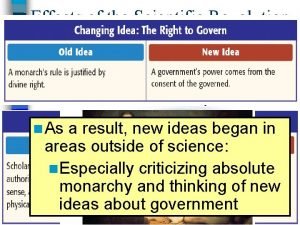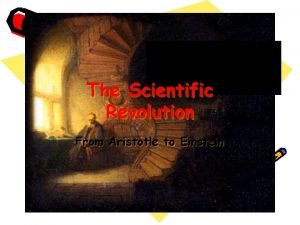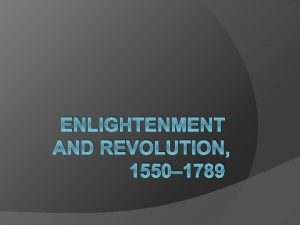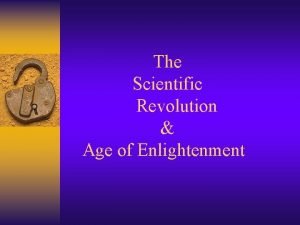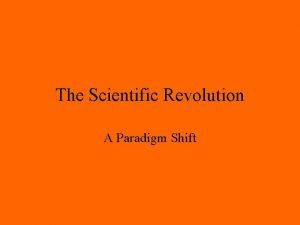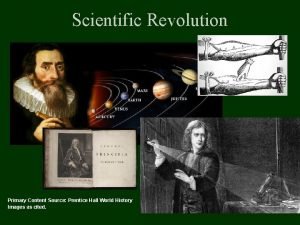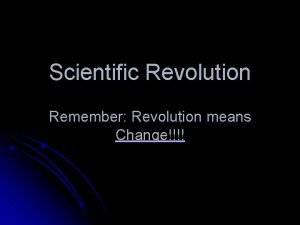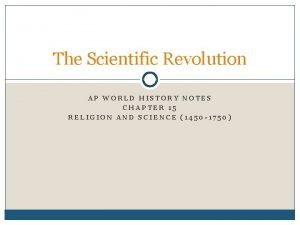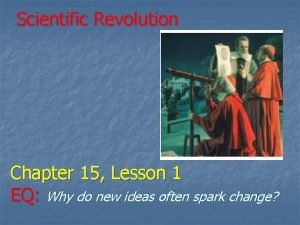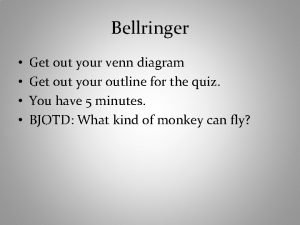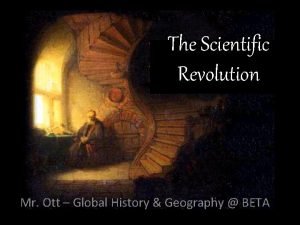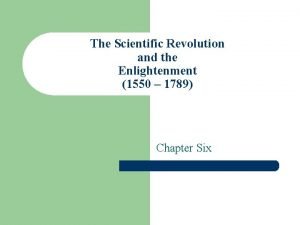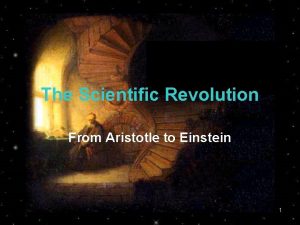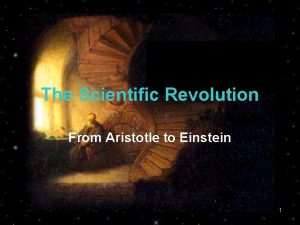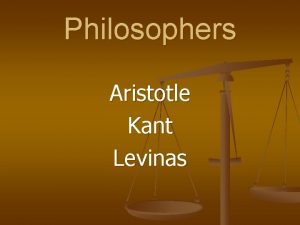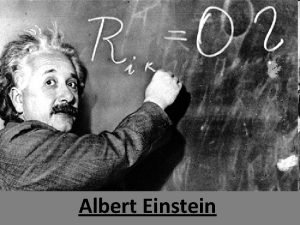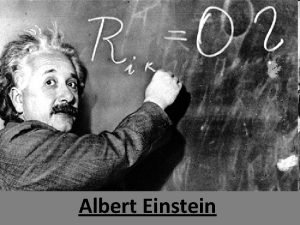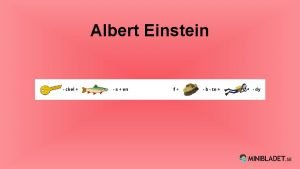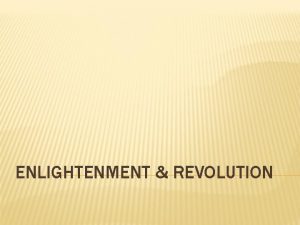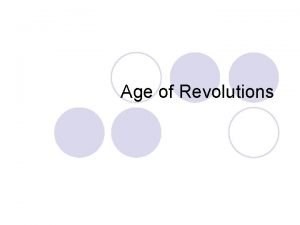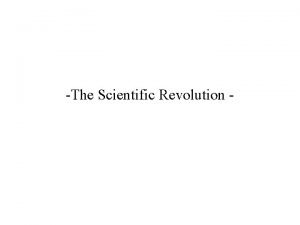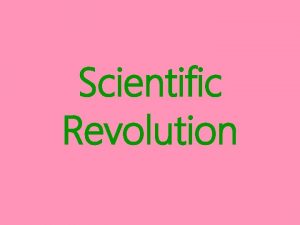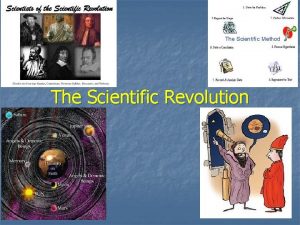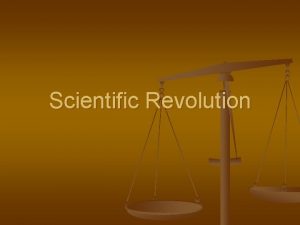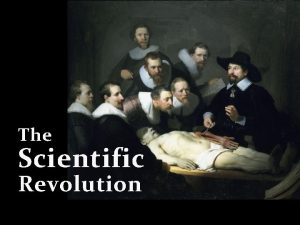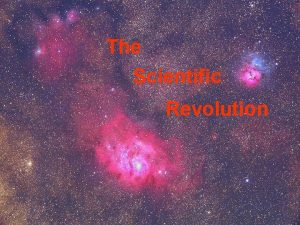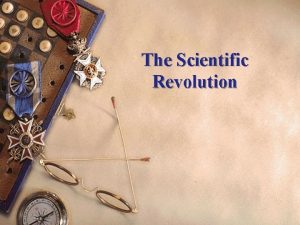The Scientific Revolution From Aristotle to Einstein 1

































- Slides: 33

The Scientific Revolution From Aristotle to Einstein 1

View of the Universe 500 Years Ago 2

3 Based on ancient speculations: “The School of the Athens” by Raphael (1510)

Aristotle’s View of the Universe: 55 crystalline spheres, celestial objects attached to spheres, spheres rotated at different velocities, the Earth was at the center. 4

Three Guiding Principles Celestial objects are made from perfect material and cannot change their properties (e. g. , their brightness). Earth is at the center of the Universe All motion in the heavens is uniform circular motion Aristotle’s Prime Mover 5

6

7

Ptolemy The Ptolemaic Universe : Ideas about uniform circular motion and epicycles 8 were catalogued by Ptolemy in 150 A. D. in his book the Almagest.

REASSURANCE Divine power would triumph over corruption and decay of earthly things and lift the soul to an afterlife in heaven COMFORT Individual could locate God. Soul’s destination would be above or below. STABILITY Earth was at center. Mankind important in God’s plan 9 Medieval Representation of Ptolemaic Universe

Aristotle’s Prime Mover became the God of Christian theology. The outermost sphere became the Christian heaven. Earth at center represented the Christian God’s concern for mankind. 10

Ideas originating with pagan Greek philosophers were incorporated 11 into the Catholic church. To challenge this view of the universe was to challenge, not only science, but theology.

Finally, Polish astronomer Nicolas Copernicus (1473 -1543) proposed a suncentered solar system. Did he get into trouble? No, On the Revolutions of the 12 Heavenly Bodies was published on his deathbed.

Copernicus’ Universe 13

Contemporary Representation of Copernicus’ Solar System 14

Since the orbits of the planets are not circles but ellipses, Copernicus could not explain all the details of planetary motion without epicycles 15

16

Johannes Kepler (1571 -1630), a German, realized that the orbits of the planets were not circles but ellipses and developed three laws to describe the 17 phenomenon he observed.

Kepler’s First Law: The orbits of the planets are ellipses, with the Sun at one focus of the ellipse. 18

Kepler’s Second Law: The line joining the planet to the Sun sweeps out equal areas in equal times as the planet travels around the ellipse 19

Galileo Galilei (1564 -1642) proved the Copernican theory with his telescope, challenged Aristotle's universe and its theological-philosophical worldview, 20 and laid the foundations for dynamics (how objects move on the earth) and gravity.

Sunspots Galileo observed sunspots that moved, indicating that the Sun was rotating on an axis and that it was not made from a perfect, unchanging substance. He observed four points of light that changed their positions around the planet Jupiter and concluded that they were moons circling the planet as it moved around its orbit. . 21

Galileo used his telescope to show that Venus went through a complete set of 22 phases, just like the Moon. This observation confirmed the Copernican system and proved that the Ptolemaic system was incorrect.

Galileo's challenge of the Church's authority got him into deep trouble with 23 the Inquisition. Late in his life, he was forced to recant his Copernican views publicly.

Sir Isaac Newton (1642 -1727) Newton demonstrated that the motion of objects on the Earth could be described by three new Laws of Motion 24 and the Universal Law of Gravitation.

Newton’s First Law of Motion: An object in motion tends to stay in motion and an object at rest tends to stay at rest, unless the object is acted upon by an outside force 25

Free Fall Air Resistance Newton’s Second Law of Motion: The acceleration of an object is directly proportional to the net force acting upon it and inversely proportional to its mass. 26

Newton’s Third Law of Motion: Every action has an equal and opposite reaction. 27

When he observed an apple fall from a tree, Newton thought: The apple is accelerated as it moves from the tree toward the ground. There must be a force that acts on the apple to cause this acceleration. Let's call the force gravity. If the force of gravity reaches to the top of the highest tree, might it not reach even further to the orbit of the Moon. Then, the orbit of the Moon 28 about the Earth could be a consequence of the gravitational force.

64. Newton’s Excellent Idea • Now came Newton's truly brilliant insight: if the force of gravity reaches to the top of the highest tree, might it not reach even further to the orbit of the Moon. Then, the orbit of the Moon about the Earth could be a consequence of the gravitational force. 29

New Inventions during the Scientific Revolution • • • Compass Telescope Microscope Thermometer Discovery of oxygen! 30

The Scientific Method • Francis Bacon • By understanding the world, scientists could generate knowledge to improve people’s lives • Experiment then draw conclusions! 31

Renee Descartes • Believed scientists needed to reject old assumptions. • Rather than experimentation, he used math and logic. • Doubt everything until proved by reason. • “I think therefore 32

Inductive and Deductive Reasoning Bacon = inductive. Descartes = deductive 33
 The third agricultural revolution
The third agricultural revolution Russian revolution vs french revolution
Russian revolution vs french revolution Economic causes of french revolution
Economic causes of french revolution Effects of the scientific revolution
Effects of the scientific revolution Enlightenment vs scientific revolution
Enlightenment vs scientific revolution What did isaac newton do in the scientific revolution
What did isaac newton do in the scientific revolution Newton's first law of motion
Newton's first law of motion Johannes kepler prezi
Johannes kepler prezi How did the reformation help spur the scientific revolution
How did the reformation help spur the scientific revolution Scientific revolution and enlightenment speed dating
Scientific revolution and enlightenment speed dating Chapter 6 the scientific revolution
Chapter 6 the scientific revolution Causes of scientific revolution
Causes of scientific revolution Effects of the scientific revolution
Effects of the scientific revolution Scientific revolution primary sources
Scientific revolution primary sources Whats the scientific revolution
Whats the scientific revolution Scientific revolution ap world history
Scientific revolution ap world history Why do new ideas often spark change
Why do new ideas often spark change Lesson 1 the scientific revolution answer key
Lesson 1 the scientific revolution answer key Scientific revolution and enlightenment speed dating
Scientific revolution and enlightenment speed dating Effects of scientific revolution
Effects of scientific revolution Enlightenment vs scientific revolution
Enlightenment vs scientific revolution Information gathered during an experiment
Information gathered during an experiment How is a scientific law different from a scientific theory?
How is a scientific law different from a scientific theory? 101012 bằng
101012 bằng Tỉ lệ cơ thể trẻ em
Tỉ lệ cơ thể trẻ em Khi nào hổ con có thể sống độc lập
Khi nào hổ con có thể sống độc lập Lời thề hippocrates
Lời thề hippocrates đại từ thay thế
đại từ thay thế Quá trình desamine hóa có thể tạo ra
Quá trình desamine hóa có thể tạo ra Công thức tiính động năng
Công thức tiính động năng Thế nào là mạng điện lắp đặt kiểu nổi
Thế nào là mạng điện lắp đặt kiểu nổi Hình ảnh bộ gõ cơ thể búng tay
Hình ảnh bộ gõ cơ thể búng tay Dạng đột biến một nhiễm là
Dạng đột biến một nhiễm là Vẽ hình chiếu đứng bằng cạnh của vật thể
Vẽ hình chiếu đứng bằng cạnh của vật thể



